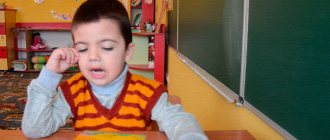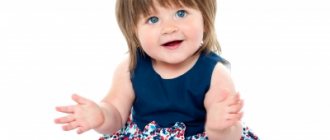Rhinolalia
With open organic rhinolalia caused by congenital facial clefts, the child’s vital functions of nutrition and breathing suffer from the first days of life. When feeding a baby, milk leaks out through the nose, so the newborn does not gain enough weight and does not receive the necessary nutrients. The inhaled air does not have time to warm up sufficiently in the nasal passages, because it immediately enters the lower respiratory tract through the cleft. Children with palatal clefts and open rhinolalia are predisposed to malnutrition, otitis media, eustachitis, bronchitis, and pneumonia. Congenital cleft palates are often combined with malocclusion.
The state of intelligence in children with open rhinolalia can be different - from normal to mental retardation and mental retardation of varying degrees. Neurological signs are often observed in children: nystagmus, ptosis, hyperreflexia.
The prelinguistic period in children with rhinolalia proceeds abnormally: attention is drawn to the absence of modulated and varied babbling, quiet or silent articulation of sounds. Speech development with rhinolalia is also delayed: the child often pronounces his first words after 2 years. Speech is slurred, inexpressive and incomprehensible to others.
With open organic rhinolalia, the articulation of sounds and sound pronunciation are grossly impaired. The root of the tongue is constantly in a raised position, and the tip of the tongue is in a passive, lowered position, and therefore most of the consonants acquire a “back-lingual” connotation and resemble the sound [x]. With open rhinolalia, all sounds have a strong nasal (nasal) connotation and are practically not differentiated from each other; the voice becomes dull and quiet.
In an effort to pronounce sounds more clearly, children strain their facial muscles, muscles of the lips, tongue and wings of the nose, which leads to grimaces and further worsens the overall impression of speech.
Inaccurate articulation and distorted sounds are accompanied by a secondary impairment of auditory differentiation and phonemic analysis, leading to disorders of written speech - dysgraphia and dyslexia. Limitation of speech contacts in children with rhinolalia leads to insufficient development of vocabulary and grammatical aspects of speech, i.e. ONR.
If a child with open organic rhinolalia realizes and experiences his defect, this causes him to develop secondary mental layers: isolation, irritability, shyness.
With open functional rhinolalia, it is mainly the sound pronunciation of vowels that suffers; consonant sounds remain intact due to sufficient velopharyngeal closure.
Closed organic rhinolalia is accompanied by a violation of the pronunciation of nasal sounds ([m], [m'], [n], [n']), replacement of [m] with [b], [n] with [d]. At the same time, the timbre of the voice also suffers; Due to the impossibility of nasal breathing, children are forced to breathe through their mouths. Children with closed organic rhinolalia are prone to colds and the development of asthenic syndrome. With closed functional rhinolalia, the voice acquires a dull, unnatural, dead tone.
Stages of speech therapy work for rhinolalia with children
Speech therapy work for rhinolalia is divided into several stages, each of which has its own meaning. Typically, the method of speech therapy for rhinolalia includes:
- Drawing up a child's characteristics.
- Speech therapy examination with drawing up a speech map.
- Preparation of the conclusion.
- Speech therapy before surgery.
- Speech therapy after surgery.
Each of the stages is equally important and skipping at least one of them is not recommended.
Speech therapy characteristics for a child with rhinolalia
To compile a profile, the child’s medical record is used, a conversation is held with the parents, and a complete medical history is studied, including the prenatal period. In most cases, rhinolalia appears due to congenital problems, so they can be identified before childbirth or immediately after it. Any information is useful for a speech therapist: how the baby ate, what operations were performed on him and at what age, how he developed. The information received is entered into a speech card for further work.
Speech therapy examination of children with rhinolalia
This stage is not unique. The study is carried out in a similar way for any other speech disorder. In total, 5 sections of speech development are studied. They are presented in the table below.
Main sections of speech therapy examination
| Section being studied | Methods and methods of examination |
| Features of the articulatory apparatus | A speech therapist studies the structure of the speech apparatus and identifies its anatomical defects:
|
| Breathing Features |
|
| Voice condition | The timbre, strength, duration, and severity of the nasal tone are noted. |
| Features of sound pronunciation | The pronunciation of vowel and consonant phonemes and articulatory postures are studied. |
| Features of speech | What is the state of developed speech, is the vocabulary sufficiently developed. |
Speech therapy report for rhinolalia
The conclusion includes information obtained from all the steps listed above, as well as general recommendations and a work plan. Rhinolalia is a widespread disease in speech therapy that requires complex work, so the specialist passes on his conclusion to doctors, defectologists, and teachers who will also participate in the correction process.
Speech therapy work before and after surgery
Since rhinolalia is defined as a disorder that combines vocal problems (nasality) and breathing problems (improper air flow), they become the main areas of work. Correction of articulation, sound pronunciation, and speech automation do not differ from those for any other speech diseases.
Work on the voice with rhinolalia begins with the formation of vowel phonemes. With their help, you can start using vocal exercises, which become the main tool in correcting vocal characteristics.
Working on breathing with rhinolalia is designed to learn how to control the air flow. To do this, exercises are carried out to establish physiologically correct breathing. Alternating nasal and oral inhalation/exhalation is effective.
At the preoperative and postoperative stages, the exercises do not change, but before the defect is eliminated, more attention is paid to breathing and voice, and after that, to sound pronunciation, although other areas of work are also present
Methods of treatment and correction
Speech impairment with rhinolalia is so obvious that it becomes impossible to do without complex treatment. Its choice depends on the characteristics of the violation, its causes and time of occurrence.
Elimination of organic characteristics
Congenital rhinolalia is caused mainly by organic defects, which can be eliminated with the help of special medical devices and surgical intervention:
- Making a pharyngeal obturator allows you to imitate the correct movements of the palate, covering the existing deficiency. With its help, breathing is normalized, the air stream is directed in the right direction, and speech is restored.
- Uranoplasty is required if the underlying disease is a cleft of the hard palate.
- Velopharyngoplasty is prescribed if the cause of the disease is cleft lips and palate at the same time or if uranoplasty did not help achieve the desired effect.
- Cheiloplasty – helps eliminate defects of the lips and nose and completely restore their original functions. It is carried out already in the first year of a child’s life.
- Adenotomy - allows you to remove lymphoid tissue from the nasopharynx so that it does not interfere with the normal functioning of the organs.
- Nasal polypotomy is required if polyps are the cause of the disorder.
- Septoplasty – allows you to change the nasal septum to improve air movement.
If primary and secondary disorders in rhinolalia in children are caused by neoplasms, a procedure is prescribed to remove them.
Elimination of functional characteristics
Functional rhinolalia in most cases is corrected by special physiotherapeutic and psychotherapeutic techniques, since it is often based on psychological problems. In addition, speech therapy work is prescribed. It includes standard operating methods:
- Gymnastics, thanks to which articulation and voice are restored with rhinolalia.
- Speech therapy massage.
- Formulation and automation of phonemes.
- Developing strength and flexibility of the vocal cords.
- Development of auditory attention, etc.
Often the organic form of the disease develops into a functional one. This occurs when a physical defect is successfully corrected by surgery, but psychological problems prevent the patient from fully using his vocal apparatus. In this case, a comprehensive treatment is prescribed, which includes all of the above correction methods.
The concept of mixed rhinolalia. Features of speech in mixed rhinolalia.
To overcome organic closed rhinolalia, it is first of all necessary to surgically eliminate the causes that impede the access of air to the nasal cavity. As a rule, with the elimination of these causes, nasal breathing normalizes and the defect disappears. If speech improvement does not occur, then after the operation a course of speech therapy training is carried out, including the following areas:
- activation of the muscles of the soft palate and posterior pharyngeal wall. Exercises similar to those used in the correction of open rhinolalia are used;
- differentiation of nasal and oral inhalation and exhalation, carried out using breathing exercises;
- establishing the correct pronunciation of sounds , , .
Corrective work to eliminate functional closed rhinolalia includes the listed areas, but given that in this case the disorder is central in nature, in some cases speech therapy is insufficient. A consultation with a neurologist is required.
Control questions
1. Define closed rhinolalia.
2. Why does the pronunciation of nasal sounds suffer the most with closed rhinolalia?
1. Name the causes of closed rhinolalia.
2. What types of organic closed rhinolalia do you know?
3. What is the cause of anterior closed rhinolalia?
4. What causes closed posterior rhinolalia?
7. What causes the occurrence of functional closed rhinolalia?
8. List corrective measures aimed at eliminating closed rhinolalia.
Why should you contact NeuroSpectrum?
Does your child have obvious or subtle speech problems? Contact the NeuroSpectrum Center for Pediatric Speech Neurology and Rehabilitation - we have experienced doctors who have the most modern diagnostic and medical equipment at their disposal. In particular, we have extensive experience working with children diagnosed with open rhinolalia - the mechanism of the disorder, symptoms, concomitant diseases and many other factors are taken into account when drawing up an individual treatment plan.
Our Center’s specialists will talk about the prevention of open rhinolalia and will carry out all the necessary examinations and medical procedures.
Correction
Even if surgery is not required, a speech therapist and speech pathologist will constantly work with the child
It is important to achieve correct articulation and production of sounds. This can be done with massage, special exercises, games.
Eliminating rhinolalia with massage and exercises
Speech therapy massage helps restore the muscles of the tongue and lips. The specialist gently massages the child's palate. In this case, the baby should not feel discomfort.
The cheeks and nasolabial folds are also massaged.
All exercises should be done in the form of a game. The speech therapist suggests:
- breathing exercises;
- inflating balloons;
- blowing out candles;
- tongue gymnastics.
It is important that the specialist interests the child. Monotonous exercises will be uninteresting to him, treatment will be ineffective
Articulation exercises
Exercises for rhinolalia can be as follows:
- Lick your lips in a circular motion.
- Open your mouth and try to reach the tip of your nose with your tongue.
- Use your tongue to touch the inside of your cheek.
All of them are aimed at strengthening the muscles of the tongue, which after rhinolalia are very weak and undeveloped.
In each case, the speech therapist selects individual programs for correcting the child’s speech apparatus. The parents’ task is to follow the specialist’s advice and work with the baby.
Stages and degrees
Depending on the form of speech impairment, the severity of distortion of words and sounds, there are 4 main degrees of severity of rhinolalia, regardless of the type of pathology.
1st degree
Rhinolalia of the 1st degree has signs of slight nasality of words with insignificant distortion of sounds. At the same time, the functions of the speech apparatus are preserved, and during a conversation with a sick person, you can understand all the phrases that he reproduces. In general, the interlocutor's speech seems normal, but with minor defects.
2nd degree
In the presence of rhinolalia of the 2nd degree, the nasal sound of words is more pronounced, and there are also gross errors during articulation.
Communication with a person does not cause much difficulty, and his speech is completely understandable to others.
3rd degree
At this stage of development of the pathology, the patient has a pronounced nasal sound of sounds and words, but speech still retains its intelligibility. During a conversation with such an interlocutor, you can understand all the words that he utters. Discomfort in the perception of sounds is associated only with their nasal sound.
In what cases should treatment be prescribed?
The main diagnosis that becomes the reason for this operation is varicose veins of the saphenous veins.
And it doesn’t matter whether it’s a small or a large vein. True, there is one prescription: laser correction is applied only if they are dilated by more than one centimeter
At the same time, the movement of the vessels themselves is smooth, without unnecessary bends. And the branches are healthy or expanded quite a bit.
This suggests that this treatment method is effective only at the initial stage of development of the disease. And if we are talking about saphenous veins.
But when the disease is advanced, or the expansion has formed by more than one centimeter, laser therapy does not guarantee that in the future the vein will not “unstick” again and the problem will not recur.
In other cases, the veins need to be removed using another treatment method.
Many experts believe that varicose veins are most effectively treated with a laser. This method is based on the use of the thermal effect. It is used for coagulation of blood vessels. In simple words, the light guide, which is inserted into the vessels, emits a certain flow of energy.
This is the process that occurs during surgery. The radiation that comes from the laser is absorbed by hemoglobin, which is present in the blood. Perhaps this is only under the influence of the heat generated, which heats the blood cells and the walls of the vessels themselves. As a result of this, the blood seems to be “squeezed out” from the vessel, and the latter simply sticks together. It also leads to a complete cessation of blood flow. Venous outflow, as a result of such intervention, occurs through other veins that are not affected by varicose veins.
To avoid complications, you must first consult with your doctor and undergo a full examination. And only after that begin this procedure.






